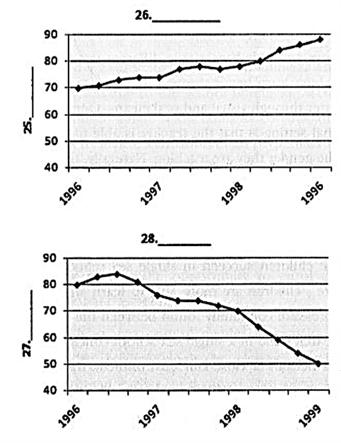IELTS reading about monster, schools, production
نمونه سوالات ریدینگ آیلتس آکادمیک پارت یک، دو و سه با پاسخ تشریحی

READING
READING PASSAGE 1
You should spend about 20 minutes on Questions 1-13 , which are based on Reading Passage 1 below.
THE LOCH NESS MONSTER
- In the Scottish Highlands there, is believed to be a monster Jiving in the waters of Loch Ness. The waters of Loch Ness are one mile wide and 24 miles long, the largest body of freshwater in the United Kingdom. To many sceptics, this monster is only a modem day myth, but to others who claim they have seen it, the monster exists and still lurks in the waters of Loch Ness today.
- Throughout Scotland, research has been done at several lakes but Loch Ness Is the icon for monsters – Nessie, as the monster is affectionately named, being the most popular of them all. Both professionals and amateurs flock to this lake with their cameras in the hope of capturing a brief glimpse of Nessie and possibly solving the mystery of the Loch Ness monster.
- The very first sighting of Nessie was as far back as 565 AD. It is believed that she ate a local farmer and then dived back into the waters, with no accounts of being seen again for over 100 years. However, since the turn of the 20th century, several other people have claimed to see her. Some people believe that old Scottish myths about water creatures such as Kelpies and water horses have contributed to the idea of tills wondrous monster lurking beneath.
- 2007 brought about the most recent sighting of Nessie. A tourist named Gordon Holmes from Yorkshire visited the Loch Ness waters and claims lie not only saw her, but has captured her on video. He claimed she was jet black, about 15 metres long and travelling in a very straight line at about 6 miles per hour. Despite this supposed evidence, controversy still reigns and opinion clearly divided about its existence. The video footage has been discredited amid accusations of tampering, whilst others claim mat the image caught by Holmes could be nothing more than a tree trunk or even one of the otters that inhabit the loch.
- Some scientists believe that the Loch Ness monster could a mirage or a psychological phenomenon in as much as sometimes we see what we want to see. Of course those who have seen her beg to differ, but many experiments have been conducted to arrive at theories to explain what it is that people could be witnessing. It has been suggested that Nessie could be related to a prehistoric animal known as a Plesiosaur, an animal that measured up to ten metres in length and is otherwise thought to be extinct, although this theory is unsupported by any data, One scientist in particular has been researching the lake itself to find out more about its history, It seems that for such a large animal to Jive in this lake it would require a vast food source, but for such an amount of fish to survive there would need to be plenty of microscopic animals called zooplankton. The only way to find out how much of this there is in the water is to measure the amount of algae. Algae needs light to survive so by measuring just how deep the daylight can penetrate the lake scientists can then start to work out what kind of population can be sustained. Despite results that suggest that the fish population was too small, the conclusions drawn were inconclusive.
- In the 1900s, a ten year observational study was carried out, recording an average of 20 sightings of Nessie per year, The phenomenon exploded in second half of the century, when photos were publicly released of a ‘flipper’, Submarines were sent into die Loch Ness to try to discover more about this creature (and now are actually run as tourist attractions). Another theory behind why Nessie rose to the top of the waters where she was more likely to be seen, was that disruption from nearby road works in the 1930s forced her to move to higher levels due to the amount of vibration fell in the water. Another argument centres on the geographical placement of the Loch, which sits on the Great Glen fault line formed over 400 million years ago. Some scientists have claimed that resulting seismic activity in the lake could cause disturbances on its surface and people could be mistaking this for Nessie.
- Up until today, there is no convincing proof to suggest that the monster is real, which, given the preponderance of digital cameras, webcams trained on the loch and other technological advances in recording equipment, suggests that the myth of Nessie may be just that – a myth. Nonetheless, accommodation all over the Scottish Highlands offers tours of the lake itself so tourists can try to catch their own glimpse of Nessie, In 2007, it was estimated that related tourism brought in an estimated £6 million to the region, thanks in pan to the attention of the film industry.
Questions 1 – 6
Do the following statements agree with the information given in the reading passage?
In boxes 1-6 on your answer sheet write
TRUE if the statement agrees with the information
FALSE if the statement contradicts the information
NOT GIVEN if there is no information on this
1 The first reported sighting of the Loch Ness monster was in 1962.
2 It is believed the idea for the Loch Ness monster may have been inspired by other stories of sea creatures.
3 The last person who claims to have seen the Loch Ness monster has video footage.
4 There is evidence to suggest that the Loch Ness monster is related to the plesiosaur.
5 Testing of algae in the loch proved that the food source was insufficient to sustain Nessie.
6 Movement along a fault line could have caused Nessie to rise to the surface.
Questions 7 -13
Answer the questions below using NO MORE THAN THREE WORDS AND/OR A NUMBER from the passage for each answer.
Write your answers in boxes 7 -13 on your answer sheet.
7 When was the first recorded sighting of Nessie?
8 What was Cordon Holmes suspected of doing to the video footage?
9 What common animal may have been caught on camera and mistaken as proof of Nessie?
10 Images of what, caused an increase in the number of Nessie enthusiasts?
11 What can visitors hoping to see Nessie travel in?
12 Disturbances caused by what could have caused the creature to surface?
13 What has promoted tourism in the Loch Ness area in recent years?
READING PASSAGE 2
You should spend about 20 minutes on Questions 14-28 , which are based on Reading Passage 2 below.
PRODUCTION
A
The ‘production line’ system of creating and assembling goods was for many years been the standard mode of operation for many industries. Cars, electronic equipment, packaging many diverse companies have employed the same methods, and most have hit two main problems, The first is that unscheduled maintenance required on essential machinery has often held up production all along the line, and the second Is the significant impact on employee morale, This has given rise to the increasingly adopted method of Total Productive Maintenance (TPM) – a maintenance program which governs the maintenance of plants and equipment. The goal of the TPM program is to markedly increase production while, at the same time, increasing employee morale and job satisfaction.
B
The concept of TPM was first developed in Japan in the late 1970s, only moving to the western world a decade later, initial success of the programme in countries such as Australia was limited, but in the late 1990s a ‘westernised’ version of TPM was launched. TPM brings maintenance into focus as a necessary and vitally important pan of the business. It is no longer regarded as a non-profit activity. Down time for maintenance is scheduled as a part of the manufacturing day and, in some cases, as an integral part of the manufacturing process. The goal is to keep emergency and unscheduled maintenance to a minimum.
C
TPM involves directing participating companies and industries to move away from traditional methods of production to more efficient mechanisms. This is evident in TPM’s operational focus on lea production rather than mass production. The lean approach favours flexibility within a team, rather than the specialisation of labour Introduced with mass production. It also involves a shift away from being driven by the financial department of the company to a more customer focussed goal. Another goal of the TPM method is to introduce quality control not by being overseen by managers, but rather by engendering a sense if responsibility amongst all staff; a move from autocratic management to empowerment. This shift means that shop floor workers are being able to take a sense of pride in their work, and with that comes the desire to perform well ultimately leading to higher productivity for the company.
D
in order to apply the concepts of TPM, a company will have to work through a number of stages. First, there must be universal agreement that the system has the potential to be successful within the company. Then a specific person or team needs to be appointed to coordinate the changes required to apply TPM methodologies, an aim that begins with training and education for all employees. Once the coordinator is convinced that the work force is sold on the TPM program and that they understand it and its implications, the first action teams are formed. These teams are usually made up of people who have a direct Impact on the problem being addressed. Operators, maintenance personnel, shift supervisors, schedulers, and upper management might all be included on a team. Each person becomes a stakeholder in the process and is encouraged to do his or her best to contribute to the success of the team effort. Usually, the TPM coordinator heads the teams until others become familiar with the process and natural team leaders emerge.
E
The concept of TPM is built on what are referred to as the three pillars – work area management, risk management and equipment management. An illustration of these pillars is highlighted in the importance of recognising and eliminating defects within the machinery used in a company, This refers to issues such as the accumulation of dust and grime on equipment, gauges that are broken or too dirty to read clearly and missing or loose bolts, nuts and screws, Using a sample company, statistics collected from a three month period Indicate a substantial reduction in machine maintenance costs, felling by $ 30,000 between 1996 and 1999. At the same time, the effectiveness of the equipment increased significantly, with machine uptime rising by almost 2096 over the same period.
F
Many observers have identified similarities between TPM and an earlier industry concept – total quality management (TQM), and in many respects, TPM and TQM resemble each other. Both require total commitment to the program by upper level management, and both promote the empowerment of all employees to initiate corrective action, Additionally, both processes require a long range outlook, as it may take a year or more to implement and is an ongoing process, Changes in employee mind-set toward their job responsibilities must take place as well, Indeed, initial results for at least the first quarter may actually lead to reduced productivity while changes are put into effect.
G
The difference between the two systems, however, becomes apparent in when looking at what each system considers to be a priority. TQM is essentially an output focussed system, whereas TPM is singular in that it looks more at input – the equipment used and the causes of real or potential maintenance failures. Also, although both programme stress the need for complete involvement of all parties, TPM stresses the equal importance of all levels of employee, whereas TQM has a more traditional focus on management structure, The main target of both is also slightly different; whereas TQM alms to improve quality, TPM aims to reduce wastage and minimise losses.
Questions 14 – 20
Reading Passage 2 has seven paragraphs A-G .
Choose the correct heading for paragraphs A-G from the list of headings below.
Write the correct number i-x in boxes 14-20 .
List of Headings
i Unique focus of TPM
ii Common issues TPM was establish to combat
iii Statistical weakness of TPM
iv The introduction of TPM
v Parallels with a former concept
vi Types of TPM coordination and training
vii Implementing TPM
viii The guiding principles of TPM
ix The impact of staff involvement
x Efficiency through involving all employees
xi The value of mass production techniques
14 Paragraph A
15 Paragraph B
16 Paragraph C
17 Paragraph D
18 Paragraph E
19 Paragraph F
20 Paragraph G
Questions 21 – 24
Complete the flowchart .
Choose NO MORE THAN TWO WORDS from Reading Passage 2 for each answer.
Agreement about the 21 offered by implementing TPM
THEN
Nomination/ establish of 22
THEN
Education and training of workforce
NEXT
Creation of 23
FINALLY
Emergence of 24 to head group
Questions 25 – 28
Label the diagram below using words from the box below. USE EACH CHOICE ONCE ONLY
Write the correct letter A – I in boxes 25 – 28 on your answer sheet
A Overall equipment effectiveness
B % uptime
C $000s / quarter
D Machine maintenance costs
E % downtime
F $000s / month
G Employee costs
H Wasted resources
I Hours spent cleaning maintaining machinery

25
26
27
28
READING PASSAGE 3
You should spend about 20 minutes on Questions 29 – 40 , which are based on Reading Passage 3 below.
CO- EDUCATIONAL VERSUS SINGLE GENDER CLASSROOMS
- It seems that across the western world, an increasing number parents are opting to return to more traditional divisions with regards their children’s education, with a significant rise in most western countries of single gender classrooms, in which the classroom set up involves the teacher working with only boy’s or only girls. For many, the issue is whether to opt for a mode of teaching that improves a child’s academic learning or to choose a co-educational schooling offering a more ‘rounded’ education. There is no doubt that boys and girls have a very different way of learning, with research showing that boys learn better through movement, sound and touch, whereas girls learn better through visual and oral means. One clear advantage of a single gender educational setting is that the teacher fs able to focus on specific styles of teaching to the gender they are teaching. Naturally, the resurgence of single gender education has meant that many teachers have had to undergo additional in appropriate techniques for the environment.
- There are many potential advantages for children studying in single gender schools, Some children succeed in single gender schools because of the lack of social pressure – children are more able to learn and grow at their own pace without the pressure commonly found between the genders in co-educational schools, Research done in a single gender school concluded that students thrived in what often became a dose-knit environment with closer interaction with teachers. In surveys of over 1000 single gender schools, it was reported that not having the opposite gender around was ‘missed’, but the absence of boys or girls allowed students to have a more direct and serious approach to their education.
- In many western countries, the traditional way of thinking around thirty years ago was that co-education would somehow break down gender stereotypes, but this hasn’t always proved to be the case, The advocates of single gender education argue that boys in coeducational settings are less likely to study the arts or advanced academic subjects just to avoid the social categorization of certain subjects as being more in the feminine realm. Equally, girls may tend avoid the sciences and technology subjects as this has traditional been more of a male domain. Single gender schools are flourishing once again as parents realise that allowing their son or daughter to learn in his or her own individual way is a very important consideration in choosing a school.
- For students attending single-gender secondary schools, there was a slight tendency for males to outperform females. In contrast, for students attending coeducational schools, there was a clear tendency for females to outperform males. It was also noted that in single gender schools girls were more likely to be involved in leadership activities such as student councils, athletic associations, and other activities additional to the school timetable. Accordingly, girls have reported to have favoured single gender schools as co-educational environments tend to be dominated by males, a situation often perpetuated by teaching staff.
- Regardless of increased levels of academic performance and preference, a small percentage of people concerned about gender equality have argued against single-gender education as an ethical issue, in that forced separation between the genders is forced on students. In order for schools to run single-gender classrooms, they must also offer parents the opportunity to enrol their children in a traditional co-educational classroom.
- In regards to those who may oppose gender segregation in schools, many advocates of the idea believe single-gender classes actually negate gender stereotypes, As mentioned earlier, in a mixed classroom, boys tend to avoid tasks related to the arts while girls show Jack of interest in science and technology. However, in single-gender environments, there is no existing bias that “this is for boys” or “that is for girls”. In fact, a 2005 study released by Cambridge University showed that in single-gender rooms, as compared to to traditional settings, girls are more interested in math and science, subjects generally preferred by boys in co-educational settings.
- It is important to remember that coeducation is a modern concept, introduced into mainstream education less titan fifty years ago, despite being a change which has brought huge changes to the societies in which this method is observed. It was first introduced in Switzerland, and swept quickly around most western countries, and is certainly not without its benefits. Parents have said that a coeducational classroom has been excellent for their children’s confidence levels, has helped them to overcome issues such as shyness and helped students to converse about everyday topics with the opposite gender, surveys have also shown that a higher percentage of girls in the classroom lower classroom disruption, also creating a better relationship between the students and the teacher.
- Which type of schooling is best comes down to what suits the individual child and which environment they best thrive in, therefore parents are recommended to seek advice and do their research before making that all important decision.
Questions 29 – 31
Choose the correct letter, A, B, C or D .
Write your answers in boxes 29 – 31 on your answer sheet.
29 In single genderclasses
30 Co-education schools
31 Parents
Questions 32 – 36
Complete the notes below USING NO MORE THAN TWO WORDS .
Co-educational schools
intended to reduce gender 32 , but actually may not be successful.
started in 33 but quickly spread.
allow students to 34 more easily with opposite sex about general topic.
Single gender schools
girls have higher interest in traditionally male dominated 35.
often have better relationship with 36
Questions 37 – 40
Do the following statements agree with the information given in the reading passage?
In boxes 37-40 on your answer sheet write
TRUE if the statement agrees with the information
FALSE if the statement contradicts the information
NOT GIVEN if there is no information on this
37 Single gender schools are becoming more popular again.
38 Girls do not learn as well as boys through speaking.
39 Surveys have found that coeducational schools are preferred socially.
40 The majority of equal opportunity activists have argued that forcing gender separation on children is unethical.


